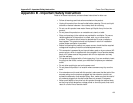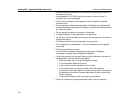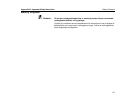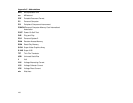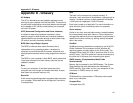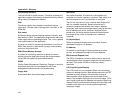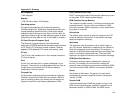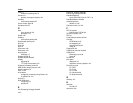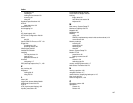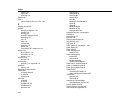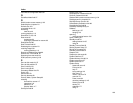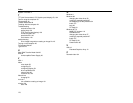
Appendix D - Glossary
163
MB (megabyte)
1,024 kilobytes.
Megabit
1,048,576 bits or about 128 kilobytes.
Operating system
A program that supervises the computer's operation,
including handling I/O. Application programs and users can
request operating-system services. A user might request
operation-system services to copy files or format a disk. An
application program might use the operating system to obtain
keyboard input, write data to a file, or write data to a screen.
PC Card (Personal Computer Card)
The Personal Computer Memory Card International
Association (PCMCIA) defines the standards used to develop
all PC Cards. PC Card types include: modems, Ethernet
adapters, SCSI adapters, ATA cards, and memory cards.
PC slot
The PC slot is the hardware slot in the computer where the
PC Card is placed.
Pixel
A pixel is an individual dot in a graphic displayed on your
computer. The pixels are so close together that they look as
though they are connected. An LCD screen displays
thousands or millions of pixels.
Plug and Play
A plug and play operating system automatically configures
computer components to work with your system. With this
type of operating system, you normally do not need to set
jumpers on devices or set memory addresses or IRQs.
POST (Power On Self Test)
POST is a test performed by the computer whenever you turn
on the power. POST checks system integrity.
RAM (Random Access Memory)
The computer's system memory, including conventional and
extended memory. You can write to and read from RAM.
Information stored in RAM is temporary, and is erased when
the system is turned off.
Refresh rate
The refresh rate is the rate at which the image on the LCD
screen is rewritten to the screen. A fast refresh rate helps
keep the image from flickering.
Resolution
The resolution is the sharpness or clarity of the image on
your LCD screen. Resolution is measured by the number of
pixels the computer’s screen can display. For example, a
resolution of 800x600 means that the screen can display 800
pixels in row and can display 600 rows. The more pixels
displayed, the higher the resolution and the better the image.
ROM (Read-Only Memory)
Permanent computer memory dedicated to a particular
function. For example, the instructions for starting the
computer when you first turn on power are contained in ROM.
You cannot write to ROM. (ROM is not the same as RAM).
Sector
Also known as
disk sector
. The portion of a track that is
numbered and can hold a specified number of characters
(usually 512 KB).
Shadow RAM
A write-protected area of RAM that contains a copy of the
BIOS. As the computer boots, the BIOS is copied from its
permanent location in ROM to RAM. The BIOS can be



